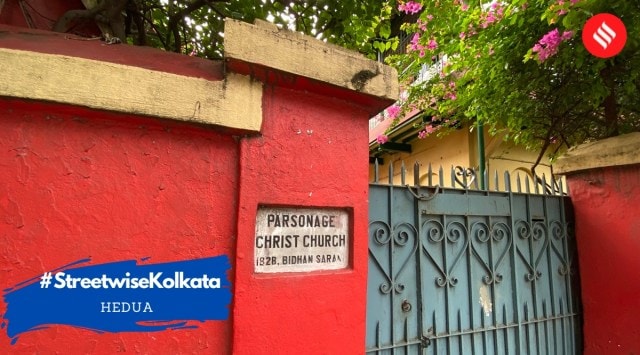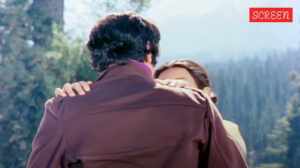Stay updated with the latest - Click here to follow us on Instagram
Streetwise Kolkata: Home to iconic mishti shops, Hedua’s history started with lakes
Housing several old rajbaris belonging to prominent zamindari families and 139-year-old mishti shops, the bylanes of Hedua are a window to old Calcutta in all its glory.
 Hedua in north Kolkata is one of those few remaining neighbourhoods in the city where you still get to see a little bit of purono Calcutta. (Express photo by Neha Banka)
Hedua in north Kolkata is one of those few remaining neighbourhoods in the city where you still get to see a little bit of purono Calcutta. (Express photo by Neha Banka) Hedua in north Kolkata is one of those few remaining neighbourhoods in the city where you still get to see a little bit of purono Calcutta – the old Calcutta that its residents, both current and former, still conjure in their minds when hit by brief spells of nostalgia.
Although officially called Azad Hind Bagh, this square is rarely ever referred to by this name. In his book ‘A History of Calcutta’s Streets’, author P Thankappan Nair writes that this neighbourhood originally belonged to one of the city’s prominent zamindar families, the Hathkhola Dutta family, who sold it to the zamindar family of Rama Kanta Mitter sometime in 1787. Nair’s writings do not fully explain the circumstances of the transaction, but there is mention of the ‘Company’ associated with this sale and purchase, perhaps indicating some degree of involvement of the British East India Company.
Nair adds an interesting detail: he writes that “Ram Tanu Dutta, who was the benamidar of Rama Kanta sold the land to the Lottery Committee in 1817 for Rs. 10,000”, indicating that this property was transacted under proxy names. The Lottery Committee sold some 12 bighas of this land following the purchase, but it is not clear to whom it was sold.
 Nalin Chandra Das, situated in the bylanes of Hedua, is among the most iconic institutions in the neighbourhood. (Express photo by Neha Banka)
Nalin Chandra Das, situated in the bylanes of Hedua, is among the most iconic institutions in the neighbourhood. (Express photo by Neha Banka)
The name Hedua finds mention in some archival texts of the city under two names, ‘Hedua Talau’ and ‘Hedua Pooker’. Nair writes that the term ‘Hedua’ is a corruption of the Bengali word ‘hrad’ for ‘lake’. Prior to the neighbourhood’s development into a square, it appears that this area had several underground springs, of which the only remnant is the lake that now forms the centre of the neighbourhood.
Covering approximately 12 bighas, the Hedua lake was reduced even further in size by the Lottery Committee when it decided to add sidewalks around it. Nair writes that this lake was one among the nine reservoirs that the Committee had constructed between 1817 and 1836 in the city.
 The name Hedua finds mention in some archival texts of the city under two names, ‘Hedua Talau’ and ‘Hedua Pooker’. (Express photo by Neha Banka)
The name Hedua finds mention in some archival texts of the city under two names, ‘Hedua Talau’ and ‘Hedua Pooker’. (Express photo by Neha Banka)
For a period in its history, the square was also called Cornwallis Square. There is history attached to this neighbourhood and it finds mention in several notable literary works and films featuring the city. In his book ‘Alternative Modernities’, Andrew Wachtel writes that in some prominent literary works of the twentieth century, it is referenced as “the park that Calcuttans usually call Hedo or Hedua”, citing Bepin Behari Gupta’s ‘Puratan Prasanga’ as an example.
According to Nair’s research, prior to this neighbourhood’s transformation into a semi-residential area, it was “a dreaded place, owing to the frequency of robberies and assaults committed there. No Indian, even for the love of money, dared to go that way after sunset.”
 The 139-year-old mishti shops of Girish Chandra Dey and Nakur Chandra Nandy in Hedua, Kolkata. (Express photo by Neha Banka)
The 139-year-old mishti shops of Girish Chandra Dey and Nakur Chandra Nandy in Hedua, Kolkata. (Express photo by Neha Banka)
Quoting an essay titled ‘Old Calcutta’, by S C Mitra, published in the December 1889 edition of the National Magazine, Nair writes, “My grandfather informs me that he distinctly remembers having seen, when he was a little boy, the localities to the east of Hadooa tank, the tracts now called Goabagan, Hathibagan, covered with dense jungle. He says that the Hadooa tank — Anglice Cornwallis Square — which has now been converted into one of the ‘lungs’ of the overcrowded native quarter of the town, was in the early part of this 19th century a stagnant pond overgrown with rank vegetation and festering with germs of disease. A few steps to the north-west just where the hackney-carriage stand is now situated were ditches partially filled with water which were the favourite resort of thieves and dacoits and the old gentleman says that he remembers having often seen corpses of murdered persons floating in them.”
 The 184-year-old Christ Church, Diocese of Calcutta, is located in Hedua, Kolkata. (Express photo by Neha Banka)
The 184-year-old Christ Church, Diocese of Calcutta, is located in Hedua, Kolkata. (Express photo by Neha Banka)
The square’s present name Azad Hind Bagh pays homage to Netaji Subhash Chandra Bose’s Azad Hind provisional government. Nair writes that in March 1947, the Calcutta Municipal Corporation decided to rename Cornwallis Square as Azad Hind Bagh.
The 144-year-old Bethune College, and the 184-year-old Christ Church, Diocese of Calcutta, are also located in this neighbourhood, as are several old rajbaris belonging to some of the city’s most prominent zamindari families. But it is the 139-year-old mishti shops of Girish Chandra Dey and Nakur Chandra Nandy, and Nalin Chandra Das in one of the many bylanes of Hedua that is among the most iconic institutions in the neighbourhood. At these two shops, if the owners happen to have a few minutes to spare from the constant flow of customers, and are willing to engage in conversation, there are many stories that they have to share, not only of their establishments and the mishti, but also of the how the neighbourhood has changed and tales that have been passed down over the generations.







